Children's Art Activity for Autumn with Blackberries
Today we foraged for blackberries with the intention to collect and print with them. We wanted to experiment with different mediums for children's art in Autumn.
Or aim was to reproduce the beautiful colours, textures and shapes found in blackberry bushes in the form of printmaking.
First of all we needed to make a background collage of leaves for the blackberries to nestle into and hide between. We could have used some real blackberry leaves but but decided, after looking closely at the shape of the leaves of a blackberry bush we found a leaf in our our bag of mixed type artificial leaves which was so very similar, if not the same.
To print the leaves we used the reverse of the leaf as the veins were raised, which meant that the detail would stand out more on the print. The leaf was painted with green paint, brushed on with a chubby paint brush for even coverage of the leaf.
Once the paper was covered in leaf prints we decided a second shade of green would look good, as the leaves outside look different from one another depending on the angle of the light. So we added a small amount of brown paint to the green which created a murkier green to go on top of the bright green leaves.
Then we were ready to paint with the blackberries. We had observed that blackberries hang in clumps on the bush and wanted to represent this. We pressed gently with a blackberry onto the paper. It was great to see that by using the blackberry itself (rather than the juice) we had created a textured look rather than an opaque print. The texture represented the little bobbles on the surface of the blackberry, known as drupes.
The colour was amazing. The watery effect was good. It was wonderful to create art work using a natural pigment. And this was the finished result.
We then wondered...
We wondered how we might paint a similar painting but without the use of real blackberries. This would make it possible to do if there were no blackberries around, for whatever reason.
This time we decided to paint a branch only. Using the same leaves, we printed them in a similar direction to one another, working from the top of the paper down. For the blackberries themselves, we printed circles with paint using a small cork. Children could use their finger tips alternatively. (Corks are great for children who do not like to put their fingers in paint)
We used purple paint with a little red and a little black. We applied the colours individually, one on top of the other to give an uneven appearance. This meant that there were different colours on each berry as there are on real berries.
Alternatively the paint colours can be mixed together before applying - a colour mixing challenge for the children to mix the exact same colour paint as a blackberry.
We found that it was more difficult to create the textured surface of the blackberry using paint compared to using the blackberry fruit, as, if we weren't careful it looked like a grape!
( Please be aware that this is a messy art activity. Blackberries juice and paint can stain - old clothes are advisable or if you need an apron, you can buy them here
Or aim was to reproduce the beautiful colours, textures and shapes found in blackberry bushes in the form of printmaking.
First of all we needed to make a background collage of leaves for the blackberries to nestle into and hide between. We could have used some real blackberry leaves but but decided, after looking closely at the shape of the leaves of a blackberry bush we found a leaf in our our bag of mixed type artificial leaves which was so very similar, if not the same.
To print the leaves we used the reverse of the leaf as the veins were raised, which meant that the detail would stand out more on the print. The leaf was painted with green paint, brushed on with a chubby paint brush for even coverage of the leaf.
Once the paper was covered in leaf prints we decided a second shade of green would look good, as the leaves outside look different from one another depending on the angle of the light. So we added a small amount of brown paint to the green which created a murkier green to go on top of the bright green leaves.
Then we were ready to paint with the blackberries. We had observed that blackberries hang in clumps on the bush and wanted to represent this. We pressed gently with a blackberry onto the paper. It was great to see that by using the blackberry itself (rather than the juice) we had created a textured look rather than an opaque print. The texture represented the little bobbles on the surface of the blackberry, known as drupes.
The colour was amazing. The watery effect was good. It was wonderful to create art work using a natural pigment. And this was the finished result.
We then wondered...
We wondered how we might paint a similar painting but without the use of real blackberries. This would make it possible to do if there were no blackberries around, for whatever reason.
This time we decided to paint a branch only. Using the same leaves, we printed them in a similar direction to one another, working from the top of the paper down. For the blackberries themselves, we printed circles with paint using a small cork. Children could use their finger tips alternatively. (Corks are great for children who do not like to put their fingers in paint)
We used purple paint with a little red and a little black. We applied the colours individually, one on top of the other to give an uneven appearance. This meant that there were different colours on each berry as there are on real berries.
Alternatively the paint colours can be mixed together before applying - a colour mixing challenge for the children to mix the exact same colour paint as a blackberry.
We found that it was more difficult to create the textured surface of the blackberry using paint compared to using the blackberry fruit, as, if we weren't careful it looked like a grape!
( Please be aware that this is a messy art activity. Blackberries juice and paint can stain - old clothes are advisable or if you need an apron, you can buy them here
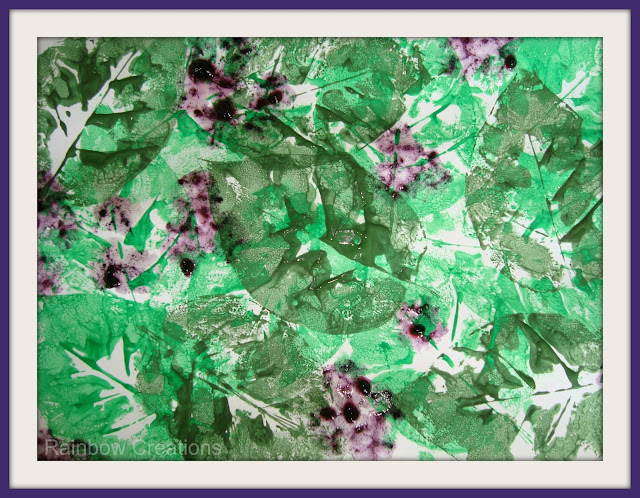

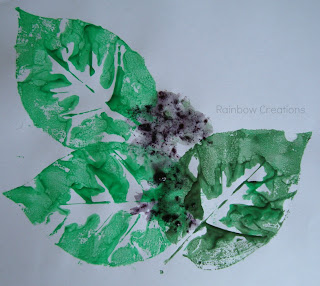

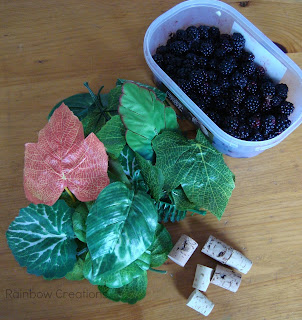

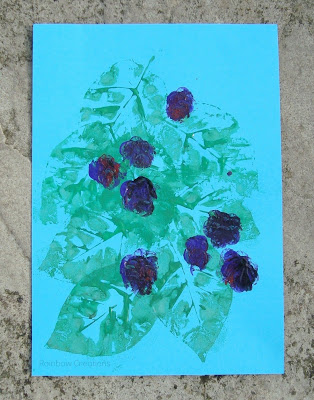

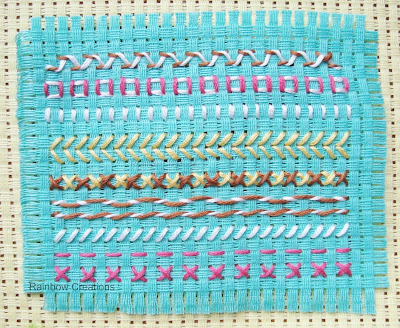

Comments
Post a Comment
Questions, comments or ideas always welcome